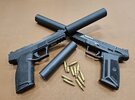I can't think of a reason in the world why a gun maker would design a new toggle action pistol today. Certainly a reliable, functional pistol could be made with modern design, manufacturing, and materials, but the market would never justify it. Remember, when the Luger was replaced in German military service, it was not because of any functional shortcomings or reliability issues, it was because the design was so fiendishly expensive to manufacture. I think it's hilarious, and ironic that for the better part of a century, people have accepted the received wisdom that the Luger, with is exposed mechanism, was unduly sensitive to, and unreliable when exposed to dirt, grit, and mud. But when Karl Kasarda and Ian McCollum of InRangeTv performed a series of tests of various firearms dunking them in mud, the Luger -- the supposedly mud-vulnerable Luger -- outperformed all the other handguns tested. It was, in fact, the only handgun rested to continue functioning unimpeded. Turns out that when the action is closed, it's pretty tightly sealed against ingress of gunk, and with the toggle action that locks like a knee joint, there are no critical locking surfaces to get gummed up with grit and dirt, it just keeps running.
But it's still a technological dead end. First off, for all its reliability (when manufactured correctly), it's expensive. You have a multiplicity of machining operations, and that costs more money. The per-unit cost for each gun goes way up. Second off, it's much harder to achieve parts interchangeability with so many separate machining operations, each with its possibility of introducing error. Lugers had every last part serial numbered so that armorers, with more than one pistol on their bench, wouldn't mix the parts up, because if they did, the guns couldn't be depended on to function. By contrast, an M1911 could mix and match parts indiscriminately, and still be counted on to run just fine, because of how much simpler production was. Third, it makes for a more ammo-sensitive gun. The toggle joint is far lighter in mass than a slide, and therefore opens and closes far more rapidly, This makes it far more critical to dial in the strength the magazine spring, and the burn rate of the powder, the bullet weight and velocity, etc. With a much faster-cylcling action, the magazine simply must push the next cartridge up into position in time. This faster cycling time makes the toggle action action, in addition to being far more expensive to manufacture, far less tolerant of variances in ammo quality.
There's a reason the Browning tilting barrel has shaken out over the last century to become by far the dominant system in handgun design. It best combines the features of reliability, accuracy, economy of production, mechanical simplicity, and parts interchangeabilty. The toggle lock, for all its particular virtues, can't get anywhere close to this successful formula to justify a revival.






